The Cananéia Quarantine Station (EQC), located on the coast of São Paulo, is the result of a public-private partnership that brings together the Ministry of Agriculture and Livestock (MAPA), the Brazilian Association of Swine Producers (ABCS), and the Brazilian Association of Genetic Companies (ABEGS) to mitigate the risk of exotic, emergency, and notifiable diseases entering Brazil, and to protect the swine inventory thereby promoting safe production and marketing.
The location of the EQC on the coast of the city of Cananéia, São Paulo, is a strategic region formed by islands, which provides favorable isolation, significantly reducing the risk of pathogen spread and it offers protection against the introduction of potentially impactful diseases.

The EQC quarantines imported pigs at a single official location in Brazil. Photos 1, 2, and 3 show the Cananéia Quarantine Station.

Photo 1. Panoramic view of the Cananéia Quarantine Station. Photo 2. Satellite location of Cananéia Quarantine Station. Photo 3. Entrance to Cananéia Quarantine Station. Source: ABCS.
In this context, the EQC plays a fundamental role. Imported pigs entering the quarantine station are continuously monitored by the official veterinary service (MAPA) and, once the clinical and laboratory examinations and quarantine are completed, they leave and are transported to Certified Swine Farms (GRSC). This animal quarantine process at EQC is dynamic, with single batches entering and exiting, “all in, all out”. Different genetics companies follow a schedule to use MAPA facilities (Figure 1).
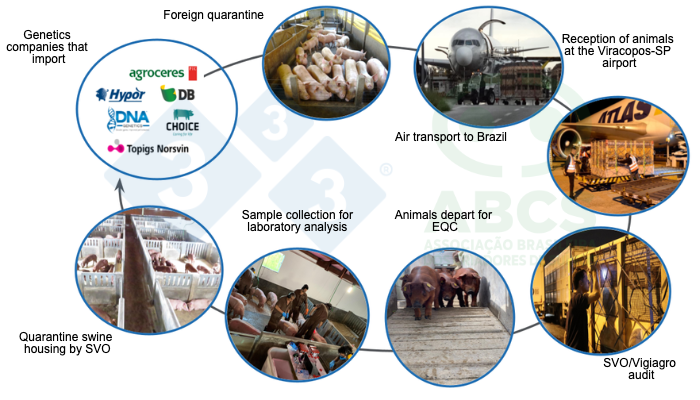
Figure 1. Photos illustrating the sequence of operations for importing breeding animals from the country of origin into Brazil for quarantine in EQC and subsequent stocking in GRSC farms (images provided by the companies). Source: ABCS.
The following describes the import procedure for pigs at EQC:
1. Imported breeding pigs arrive from the country of origin destined for Brazil.

Photos provided by the company Topigs Norsvin.
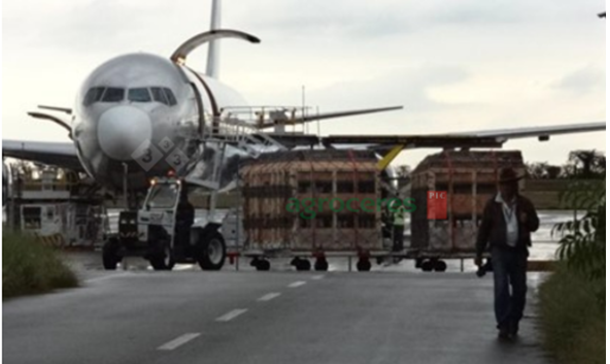
Photo provided by the company Agroceres PIC.
2. The imported pigs are unloaded at Viracopos airport (Campinas/SP), which receives the international live cargo. The Federal Revenue Service (RF) handles all the paperwork and tax clearance.
3. The unloaded animals are transferred to the airport waiting area, where they are inspected by the Agricultural Surveillance (Vigiagro/MAPA), the entity in charge of maintaining livestock health of the imports, in compliance with the terms of international transit.
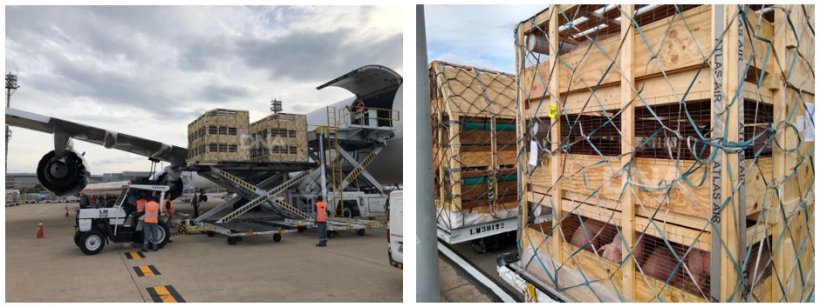
Photos provided by the company DNA South America.

Photos provided by the company Topigs Norsvin.
4. After meeting the requirements of Vigiagro and RF, the pigs are loaded and transported from Viracopos International Airport to the Cananéia Quarantine Station.


Photos provided by the company Agroceres PIC.
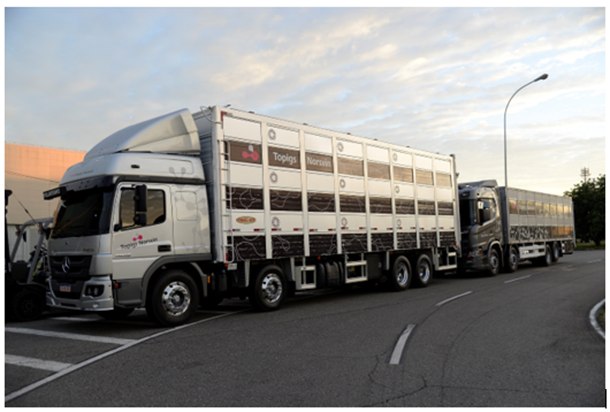
Photo provided by the company Topigs Norsvin.
5. After the land transit of the breeding males and females, the Official Veterinary Service (SVO/MAPA) receives the animals in EQC, and together with the genetic company technician, they proceed to unload the animals. Then, quarantine is carried out with continuous monitoring.
6. During the quarantine period (about 30 to 45 days), clinical examinations are performed on all animals, samples are taken for laboratory analysis, and a zootechnical inspection is carried out to issue the Genealogical Registration Certificate for each breeding pig.
The mandatory tests are Aujeszky's disease, classical swine fever (CSF), African swine fever (ASF)**, leptospirosis, transmissible gastroenteritis (TGE), porcine reproductive and respiratory syndrome (PRRS), and porcine epidemic diarrhea (PEDV). **ASF testing will be performed as soon as there is an accredited/recognized laboratory for this purpose (import of animals) in Brazil.
Keep in mind that Brazil has a sanitary status free of ASF, CSF - divided into a Free Zone (ZL) and Non-Free Zone (ZnL), PRRS, PEDV, TGE, and foot and mouth disease (free country with and without vaccination).

Photos provided by the company DNA South America.
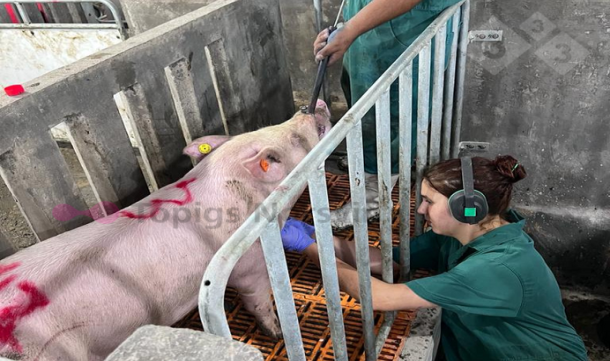
Photo provided by the company Topigs Norsvin.
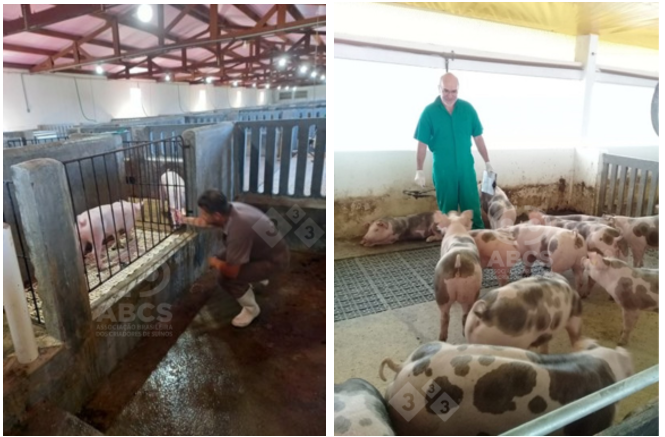
Photo provided by ABCS.
7. After completing the quarantine period at EQC and performing all examinations and laboratory analysis, the evaluation and authorization will be done by SVO/EQC/MAPA. With the permit issued by SVO, the animals are ready to be shipped, transported, and sent by land to the genetic company's nucleus farm. Upon arrival at the nucleus farm, the pigs are subjected to examinations and quarantine (30 days). If fit, the animals will be released for internal transport and settle into the nucleus farm.
Each genetics company has its own veterinarian in charge who, together with the SVO monitors imports and the other stages of the process during quarantine at EQC, monitoring transportation and housing at the nucleus farm (Figure 2).
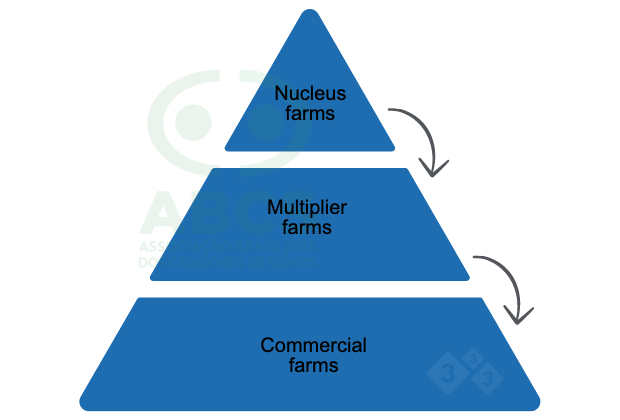
Figure 2. The pyramid structure of a swine genetic improvement program. The nucleus farms are the apex of the pyramid and contain purebred or synthetic herds (with high genetic value pigs). Multiplier farms multiply the genetic material produced in the nucleus farms. Commercial farms receive genetic material from multiplier farms and are pigs destined for slaughter. Source: ABCS, 2013.
Table 1. Number of quarantines carried out at the Cananéia Quarantine Station in the last 5 years and the total number of breeding pigs (males and females) imported to populate the nucleus farms and bring new genetics into Brazil.
| Year | Number of quarentines | Imported breeding pigs |
|---|---|---|
| 2019 | 11 | 1,490 |
| 2020 | 11 | 2,173 |
| 2021 | 14 | 2,740 |
| 2022 | 22 | 1,627 |
| 2023 | 25 | 5,726 |
| Total: 13,756 | ||
EQC is dedicated to quarantine activities for various animal species and can be used for both import and export purposes. The techniques and procedures used during quarantine are constantly under development and improved following the advancement of technical and scientific knowledge in the area and with the recommendations of the World Organization for Animal Health (WOAH).


